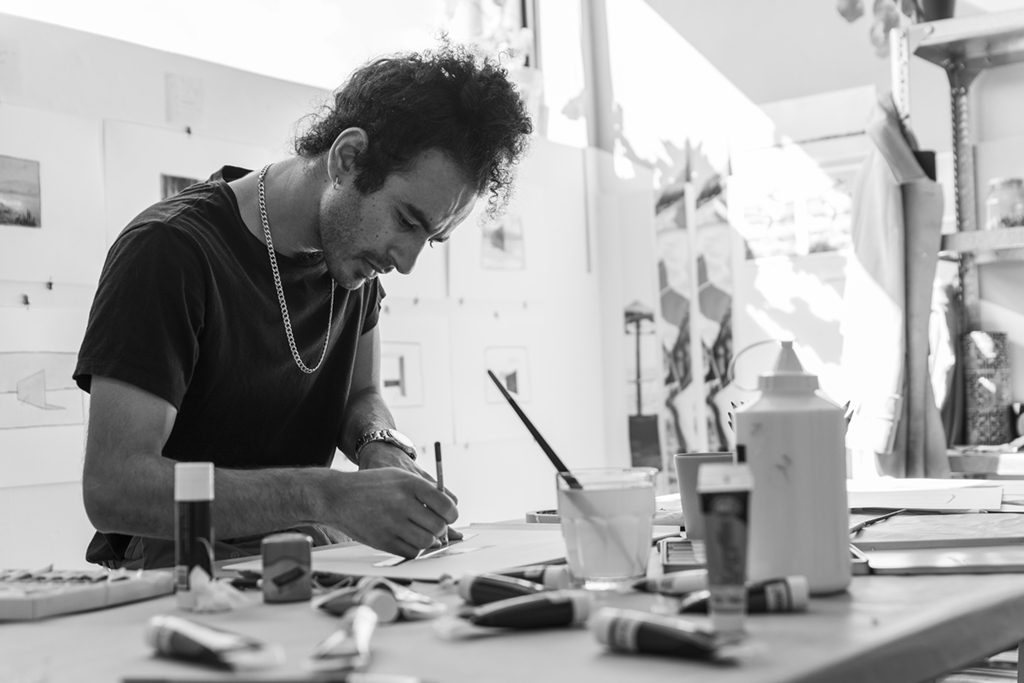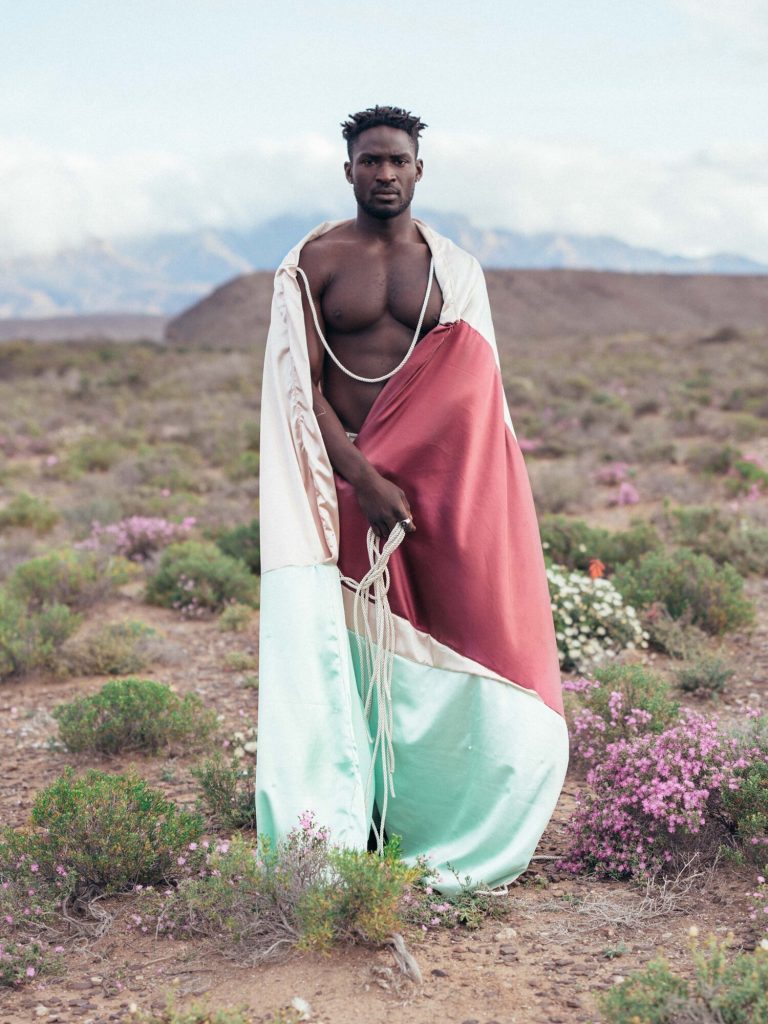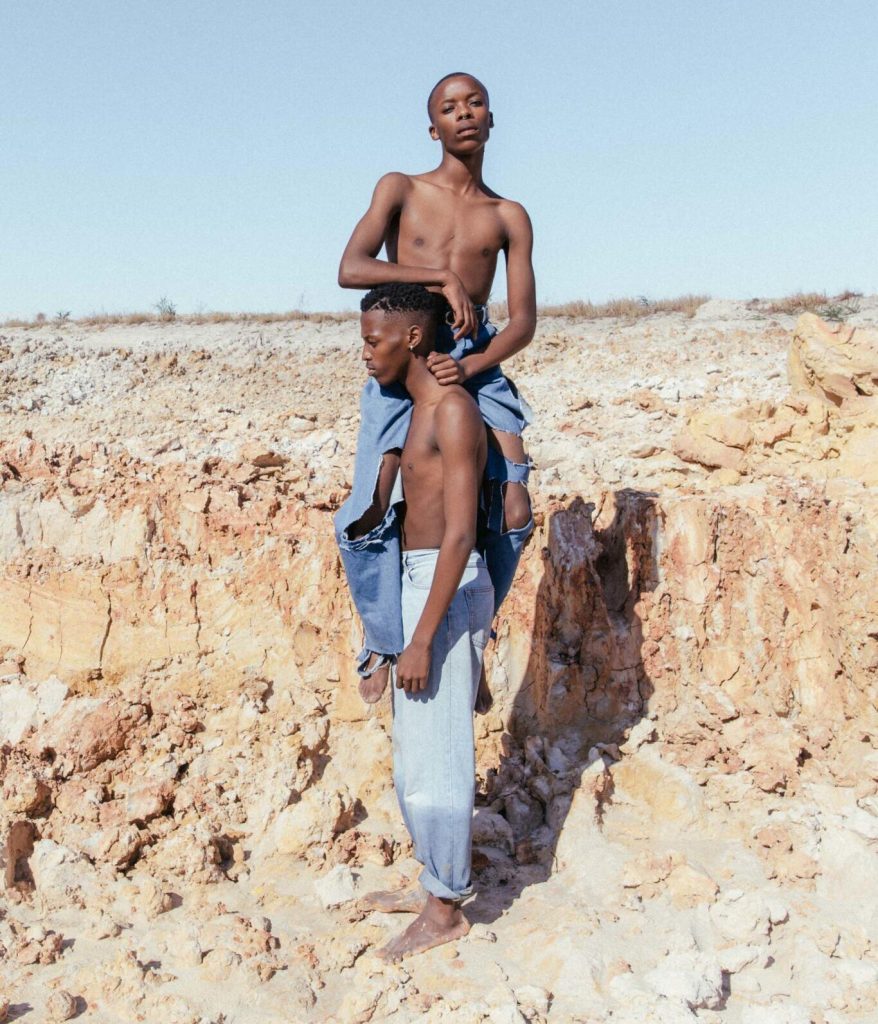“I want to move away from describing these narratives from the angle of hopelessness, loss, and absence. I want to push a more celebratory narrative that is fantastical, soft, and imaginative and fuelled by the unshakable belief in an abundance.”
-Micha Serraf
South Africa-based photographer Micha Serraf (b. 1994), whose work explores the construction and deconstruction of identity, belonging, Blackness, and masculinity, is the 2021 Ritzau Art Prize recipient.
We are honored and grateful to the artist for their interview with us, special to tripgiving.org and 1-54.com about their search for home and embrace of fantasy.

Q. You fled Zimbabwe, live in Cape Town, and “have been searching for home” while at the same are embracing “being an alien.” In your work, you explore alien identities and alien peripheries. Can you talk about this notion of “alien,” and as you say, “figuring out what I am and where I belong?”
A. When we left Zimbabwe, I was almost 10 years old. My mother told us one morning, “Today is your last day of school, say goodbye to your friends.” I remember saying goodbye to my friends as if I was going to see them the following day. After living in South Africa for a couple of years we still felt, “This is not ours. We are not of here.” South Africa is mine but it is not home–Zimbabwe is home, but it is not mine. I am constantly trying to navigate spaces that appear familiar and that I can fully recognize and understand but still feel very surreal and almost two-dimensional–like a set.
Am I the only one who feels this way? Having experienced racism, xenophobia and suspicion while traveling and living with a Zimbabwean passport, I’ve come to accept that perhaps I don’t just feel extra-terrestrial but need rather fully to embrace being an alien.
Q. You say that your work is other-worldly yet familiar, soft and afrofuturistic. How is your socially concerned photography also a platform for inclusivity for other identities that exist on social, creative and mainstream peripheries?
A. My work exists as a sort of map. A navigational tool that I design around a sense of unidentified nostalgia. A nostalgia that I feel deeply for places, time, and spaces that I have never experienced or that may not even exist. I want to take familiar landscapes and well known spaces and photograph them in a way that estranges the perspectives of those who identify strongly with them.
Photography is my medium of choice because it comes with the idea of an objective documentation and truth and therein an almost implicit authority that something exists. This allows viewers to believe what they see and feel for themselves as opposed to primarily trying to relate to me.
My intention is to try and create work for people who do not feel like they belong and for people who feel like they may belong but do not fully recognize the place they belong to. I think there is some room, or the possibility, to blend this feeling of belonging and disbelonging into an entirely new space altogether. A space where we can design and construct a space based on how we feel, as opposed to attempting to impart new and personal meaning onto an already existing (and potentially painful) one.

Q. May we ask you to talk about this photograph which is a very soft and intimate but piercing photograph made with sensitivity and depth?
A. The title of this piece is a farewell greeting that means “travel well” or “go well” in Shona–the language of my mother’s people. I imagine these were the last words whispered to us before we left. I crafted this parachute out of sheets of satin and sewed diamonds into the fabric. The parachute is made of three colors that pay a subtle homage to the LGBTQI+ genderqueer flag and community. I imagine that when we landed on Earth our parachutes were made of silk and embedded with precious stones.
I want to move away from describing these narratives from the angle of hopelessness, loss and absence. I want to push a more celebratory narrative that is fantastical, soft, and imaginative and fueled by the unshakable belief in an abundance. I am not trying to make work that is intentionally heavy or painful but that celebrates being soft despite the journey, and the sense of community, resilience, and independence that comes with it.
We left and it was hard. I want to praise and commemorate not having had an easy, secure and stationary life and the strength that it demands. The subject in this piece is a friend of mine from Ghana in a completely indigenous South African landscape draped in a satin parachute. How did he get here with nothing on his back? A lot of people have to travel with nothing or arrive with nothing and I would like to recognize the glory of their journey.

Q. Would you talk about the subjects in this affecting, striking photograph and how it relates to your interest in Blackness, queerness, and masculinity?
A. Poshi translates to “one” in English. In this photograph are two South African male-passing people who identify as non-binary and are dear friends. In these bodies of work, I only photographed people I know or who are friends of mine rather than models. People feel more comfortable and safe with someone they know and can trust as there’ll already be an inherent emotional connection. This connection between myself and my subjects is visible to the viewer and aims to encourage them to lower their guard. The act of lowering one’s guard is important to me as my work is an attempt at narrowing the gap between strangers, humans and aliens. I think the closer the subject gets to revealing themselves, the closer the viewer can get to the work. What is important about this photograph is that the person at the bottom shows no physical exertion as if there is no weight on their shoulders. No burden bared. An almost weightlessness to love and support.
Q. You are the second Ritzau Art Prize recipient. How do you plan to use your physical residency in New York City?
A. Recently when I visited the United States of America for the first time, I was registered as a ‘legal alien.’ I found this to be both pejorative and a rather humorous way of formally categorizing someone. Were they aware of my alien origin story or was it just an official way of informing foreign nationals that there are Americans and then there are aliens? Due to a confluence of factors causing hostility in post-apartheid South Africa, the word ‘alien’ is associated with negative connotations and come with xenophobic implications. This reclamation of the word ‘alien’ in my work extends a hand to undermined and peripherized identities.
With this residency, I plan to contact people who also identify as being alien or who have always been treated as such. To create a series of works that are new yet feel safe, peaceful and like home. In these scenes will be some of the people I have made contact with who will help describe the feelings that will inform my work. I think it will be a surreal experience if I am able to relate more closely to the aliens in America than to the local people of South Africa.